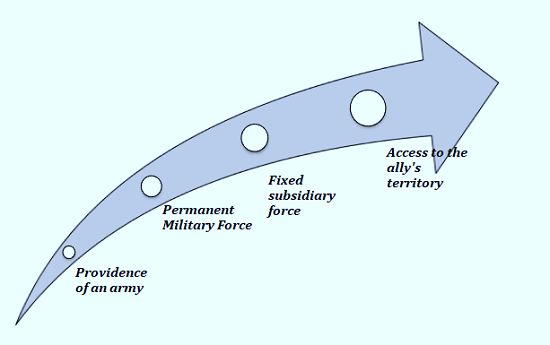

The Nawab of Awadh was the first person to enter into that treaty after the battle of Buxar during the period of the Subsidiary Alliance. This treaty was first formed by the governor-general of India whose name was Lord Wellesley. It first came into use by the French governor-general Marquis Dupleix. It was also pioneered by the French East India Company governor who later on created the treaties with the Nizam of Hyderabad and with other princes of India.
The Subsidiary Alliance was actually a policy of Non-Intervention that was mainly made to develop the British Empire. According to the treaty every ruler had to pay a certain amount of tax to the British to build and to maintain the British army. The Nawab of Awadh had to agree with this treaty to protect him from any kind of trouble and internal rebellions. This kind of alliance made the treasury of the state to become empty. Due to this the rate of poverty increased day by day.
The features of the Subsidiary Alliance led to a huge impact on the development of the British Empire and to a large downfall in the economic condition of the country. Many Indian rulers had to stop their own armies from attacking the British and they had to allow the British soldiers to do whatever they liked to do They were forced to pay taxes to the British Government. If someone refused to pay then a certain portion of land was snatched away from them.
Due to this Alliance, the East India Company protected certain provinces of India from any kind of external attacks. The British always used to interfere in the country’s important affairs and the oaths to protect the Indian Provinces were rarely honoured. They mainly stopped any foreign country to form an alliance with India Without the sanction of the British government, any kind of political issue was not allowed to occur in the country. As a result, the Indian Emperors lost their grip on the foreign countries and over the military.

The stages of the Subsidiary Alliance were divided into four major stages and these four stages led to a serious impact on the Indian economy and to the employment of the country. In these stages, the Indian rulers started losing their own freedom and the impact scattered the unity of the nation. In the first stage, the British pledged an oath to provide a limited number of soldiers In the second stage, the English East India Company committed that they would keep a permanent military force to collect an annual sum of money. In, the third stage they pledged for keeping their army within the borders of most parts of the country. In the last and final stage, Lord Wellesley took control of the emperor’s territory.
The effect of the Subsidiary Alliance was devastating for the country
Many of the Indian kings and rulers were slowly losing their independence and they were coming under British rule.
As a result of which many people were unemployed and the rulers had to disband their armies.
Lord Clive took advantage of the situation and made a deep friendship with the enemies of many foreign countries to devastate India .
In 1798 the Nizam of Hyderabad had to accept the Subsidiary Alliance.
The advantages of the Subsidiary Alliance are mentioned in various ways they are
The Subsidiary Alliance provided many resources to the East India Company.
It enhanced the soldiers' gain and expense under the local authorities.
In other circumstances, if any damage occurred due to war the British used to give certain compensations to the militants of their army
The French army lost its influence slowly.
The English East India Company continued their expansion to flourish over the country.
The Subsidiary Alliance proved to be very fruitful for the Britishers but on behalf of that, but it proved to be a very big drawback for the Indian people. The emperors of India started to gain their powers based on the matters of the state. Many people became unemployed due to the disbanding of the military forces due to which they lost their own jobs. During that time period, the patriotism among the Indians began to lose.
The freebooting activities majorly dissolved most of the Indian army and many religious conflicts arose among them. The British were able to make most of the famous rulers powerless. The well-known emperors were constantly being defeated by their enemies as the British government supported them As a result, the common people started to lose their own independence and bore a lot of torture from them.
The Subsidiary Alliance was made for the first time by The British East India Company. The company was made for their own benefit. The main motive for this Alliance was to cheat the all-powerful emperors of the country and to steal all sorts of precious items which would help them to grow their own armies and to become one of the most powerful rulers of the world. The various consequences led to certain impacts that slowly started to destroy the economy and the unity of the nation.
Q1. Who was the pioneer of the Subsidiary Alliance?
The Subsidiary Alliance was mainly held under the French governor of the East India Company. In late 1740 and established treaties for the Nizam of Hyderabad and with other Indian princes.
Q2.What was the main motive of the Subsidiary Alliance?
The main motive of the Subsidiary Alliance was to enhance the power of British rule. They intended to do so by defeating all-powerful kings or Nawabs of India by making the treasury of India empty.
Q3.Who mainly entered the Subsidiary Alliance?
After the third Anglo-Maratha war, the second Baji Rao accepted the Subsidiary Alliance. It was accepted in several states like Hyderabad, Tanjore, Awadh and many more.